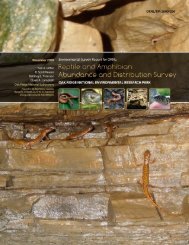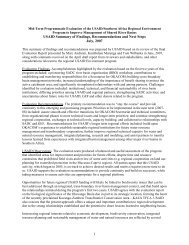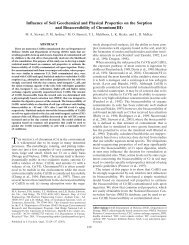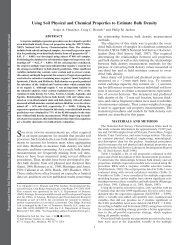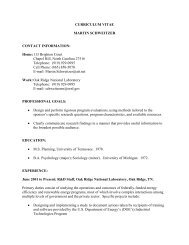oak ridge reservation physical characteristics and natural resources
oak ridge reservation physical characteristics and natural resources
oak ridge reservation physical characteristics and natural resources
Create successful ePaper yourself
Turn your PDF publications into a flip-book with our unique Google optimized e-Paper software.
Road Checking Station, (3) New Bethel Baptist Church, (4) George Jones Memorial Baptist Church<br />
(also known as Wheat Church), (5) Freels Cabin, <strong>and</strong> (6) the ORNL Graphite Reactor. Figure 10<br />
shows the general locations of registered historic places, cemeteries, churches, a national historic<br />
l<strong>and</strong>mark, <strong>and</strong> old home structures. Many other sites on the ORR, both historic <strong>and</strong> archaeological,<br />
have been determined to be eligible for listing in the National Register of Historic Places. The X-10<br />
Graphite Reactor at ORNL was also designated as a national historic l<strong>and</strong>mark on December 21,<br />
1965, based on the national <strong>and</strong> international significance of its contributions to science <strong>and</strong><br />
technology.<br />
12. SPECIAL DESIGNATIONS<br />
The ORR has evolved into a biologically rich resource over the last 60 years (see Chap. 8).<br />
The combination of long-term protection for the l<strong>and</strong> area <strong>and</strong> the biological richness of the<br />
ORR with the available research capability <strong>and</strong> proximity of diverse scientific expertise has resulted<br />
in the following state, regional, national, <strong>and</strong> international designations:<br />
• the DOE National Environmental Research Park,<br />
• ParkNet (a network of seven DOE National Environmental Research Parks),<br />
• the National Environmental Research Park Biosphere Reserve,<br />
• a unit of the Southern Appalachian Biosphere (with the Great Smoky Mountains National Park,<br />
Coweeta Hydrologic Laboratory, <strong>and</strong> others),<br />
• the Southern Appalachian Man <strong>and</strong> the Biosphere Cooperative (with the U.S. Department of<br />
Agriculture; TVA; the Economic Development Administration; EPA, Region IV; the U.S. Fish<br />
<strong>and</strong> Wildlife Service; the U.S. Geological Survey; the National Park Service; the U.S. Forest<br />
Service; <strong>and</strong> the states of Tennessee, North Carolina, <strong>and</strong> Georgia),<br />
• Oak Ridge Wildlife Management Area, managed by the Tennessee Wildlife Resources Agency<br />
(TWRA),<br />
• the Three Bend Scenic <strong>and</strong> Wildlife Management Refuge Area,<br />
• the Black Oak Ridge Conservation Easement Area, <strong>and</strong><br />
• the DOE National Environmental Research Park User Facility.<br />
Figure 11 shows l<strong>and</strong> management <strong>and</strong> operational uses on the ORR, including special<br />
designations.<br />
12.1 OAK RIDGE WILDLIFE MANAGEMENT AREA<br />
The entire ORR is a Tennessee Wildlife Management Area (Fig. 11) through an agreement<br />
between DOE <strong>and</strong> TWRA. The agreement provides for protection of wildlife habitat <strong>and</strong> species<br />
(including several threatened <strong>and</strong> endangered species) <strong>and</strong> restoration of other wildlife habitat <strong>and</strong><br />
species. Management of the ORR for wildlife is also a type of l<strong>and</strong> use.<br />
About 2920 acres (1182 ha) of the Oak Ridge Wildlife Management Area are specifically<br />
managed by TWRA under a separate agreement with DOE. This area is known as the Three Bend<br />
Scenic <strong>and</strong> Wildlife Management Refuge Area <strong>and</strong> includes most of Solway, Freels, <strong>and</strong> Gallaher<br />
Bends along the Clinch River on the southern boundary of the ORR (Fig. 11).<br />
Approximately 3000 acres (1214 ha) in the northwestern part of the ORR were placed in a<br />
conservation easement in April 2005. TWRA manages the l<strong>and</strong> in accordance with a plan developed<br />
jointly by the Tennessee Department of Environment <strong>and</strong> Conservation (TDEC) <strong>and</strong> TWRA with<br />
24




